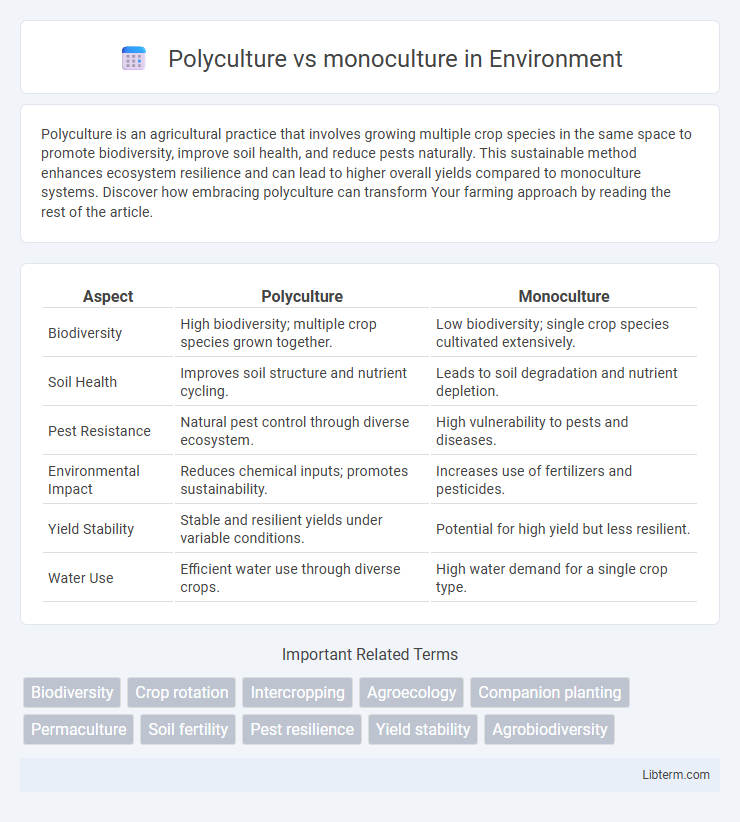Polyculture is an agricultural practice that involves growing multiple crop species in the same space to promote biodiversity, improve soil health, and reduce pests naturally. This sustainable method enhances ecosystem resilience and can lead to higher overall yields compared to monoculture systems. Discover how embracing polyculture can transform Your farming approach by reading the rest of the article.
Table of Comparison
| Aspect | Polyculture | Monoculture |
|---|---|---|
| Biodiversity | High biodiversity; multiple crop species grown together. | Low biodiversity; single crop species cultivated extensively. |
| Soil Health | Improves soil structure and nutrient cycling. | Leads to soil degradation and nutrient depletion. |
| Pest Resistance | Natural pest control through diverse ecosystem. | High vulnerability to pests and diseases. |
| Environmental Impact | Reduces chemical inputs; promotes sustainability. | Increases use of fertilizers and pesticides. |
| Yield Stability | Stable and resilient yields under variable conditions. | Potential for high yield but less resilient. |
| Water Use | Efficient water use through diverse crops. | High water demand for a single crop type. |
Introduction to Polyculture and Monoculture
Polyculture is an agricultural practice that involves cultivating multiple crop species or varieties in the same space, promoting biodiversity and enhancing ecosystem resilience. Monoculture, in contrast, relies on growing a single crop species extensively, which can increase vulnerability to pests and soil degradation. Understanding the differences between polyculture and monoculture is crucial for developing sustainable farming systems that balance productivity with environmental health.
Defining Polyculture: Principles and Practices
Polyculture involves cultivating multiple crop species or raising various animal species in the same space, enhancing biodiversity and ecosystem resilience. Key principles include crop diversification, complementary resource use, and natural pest control, which together improve soil health and reduce dependency on chemical inputs. Practices such as intercropping, agroforestry, and integrated animal husbandry optimize land use and promote sustainable agricultural productivity.
Understanding Monoculture Systems
Monoculture systems involve cultivating a single crop species over extensive areas, which can maximize short-term yields and simplify management practices. However, these systems are highly susceptible to pests, diseases, and soil nutrient depletion, leading to increased reliance on chemical inputs such as fertilizers and pesticides. Understanding monoculture's impact on biodiversity and ecosystem services is crucial for developing sustainable agricultural strategies that balance productivity with environmental health.
Historical Development of Farming Methods
Polyculture, practiced since ancient times, involves growing multiple crop species simultaneously, enhancing biodiversity and soil health, as evidenced in traditional Native American "Three Sisters" farming. In contrast, monoculture emerged prominently during the Agricultural Revolution and industrial farming era, emphasizing large-scale, single-crop cultivation to maximize yield and mechanization efficiency. The historical shift from polyculture to monoculture has led to significant changes in land use, pest management, and environmental impact.
Ecological Impact: Biodiversity in Polyculture vs Monoculture
Polyculture enhances biodiversity by supporting diverse plant and animal species, which improves ecosystem resilience and reduces vulnerability to pests and diseases. Monoculture, in contrast, diminishes biodiversity by cultivating a single crop species extensively, leading to soil degradation, increased pest outbreaks, and the need for chemical inputs. The ecological impact of polyculture promotes natural pest control and nutrient cycling, while monoculture often results in ecosystem imbalances and reduced habitat variety.
Productivity and Yield Comparison
Polyculture systems often enhance overall productivity by cultivating multiple crop species simultaneously, which improves resource use efficiency and soil health, leading to more stable yields over time compared to monoculture. Monoculture typically achieves higher short-term yield for a single crop due to specialization but faces greater risks of pest outbreaks and soil degradation that can reduce long-term productivity. Studies show polyculture yields per unit area can match or exceed monoculture totals when measured as combined outputs, offering a more resilient and sustainable agricultural model.
Soil Health and Fertility Management
Polyculture enhances soil health by promoting biodiversity, which supports nutrient cycling and reduces soil erosion compared to monoculture systems. Diverse root structures in polyculture improve soil structure and microbial activity, leading to better fertility management without heavy reliance on synthetic inputs. Monoculture, often associated with nutrient depletion and increased vulnerability to pests, demands intensive fertilization and soil amendments to maintain productivity.
Pest and Disease Control in Different Systems
Polyculture systems enhance pest and disease control by promoting biodiversity, which supports natural predators and disrupts pest life cycles, reducing reliance on chemical pesticides. Monoculture systems, characterized by uniform crops, often face increased vulnerability to pest outbreaks and disease spread due to lack of ecological resilience. Integrating diverse plant species in polyculture creates a balanced ecosystem that naturally suppresses pests and minimizes pathogen transmission.
Economic Considerations for Farmers
Polyculture systems diversify crops, reducing economic risk by stabilizing income through multiple revenue streams, unlike monoculture which depends heavily on a single crop's market price. Farmers practicing polyculture often face lower input costs due to natural pest control and improved soil health, leading to enhanced long-term profitability. However, monoculture benefits from mechanization and specialized market access, offering higher short-term yields but increased vulnerability to price fluctuations and crop failure.
Future Trends and Sustainable Agriculture Practices
Polyculture systems enhance biodiversity and soil health, promoting resilience against climate change and pests, making them a key component of sustainable agriculture's future. Emerging trends emphasize integrating diverse crop species and agroforestry to reduce chemical inputs and improve ecosystem services compared to monoculture's resource-intensive methods. Advances in precision farming and genetic research support optimizing polyculture yields while maintaining environmental balance, positioning polyculture as a promising strategy for sustainable food production.
Polyculture Infographic

 libterm.com
libterm.com